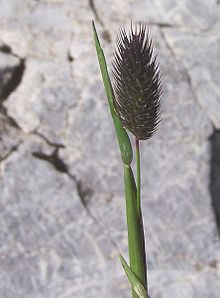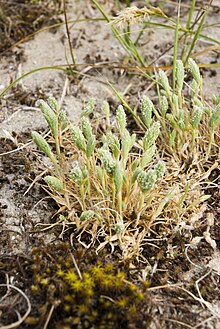Timothy grass
| Timothy grass | ||||||||||||
|---|---|---|---|---|---|---|---|---|---|---|---|---|

Meadow timothy ( Phleum pratense ), illustration in the middle and right, steppe timothy ( Phleum phleoides ) on the left |
||||||||||||
| Systematics | ||||||||||||
|
||||||||||||
| Scientific name | ||||||||||||
| Phleum | ||||||||||||
| L. |
The Phleum ( Phleum ) are a genus of grasses (Poaceae), which are native to the temperate regions of the northern hemisphere. They are placed in the tribe of the Poeae.
features
Timothy grasses are annual and clumpy growing or perennial and herbaceous plants with numerous shoots. The shoot formation can take place extra- or intravaginally. Some species have a rhizome and form runners. The stems are erect or ascending, and more gnarled . The internodes of the stems are hollow, the nodes bare. The flowering shoots reach a height between four and 150 centimeters.
The leaf sheaths on the stem are free to the base. The uppermost leaf sheath lies against the stem or is clearly inflated. The ligula is a membranous border. The leaf blades are flat or slightly curled, and ribbed on both sides. The vascular bundles are clearly recognizable as ribs, the midrib is not clearly visible. Sklerenchyma is always associated with the vascular bundles.


The inflorescence is a densely capped panicle ear. The shape is egg-shaped to cylindrical-cylindrical. The panicle branches are free or grown together with the main axis. They are up to an inch long and richly branched. The individual spikelets are short stalked. They are single-flowered with hermaphrodite flowers and have a short axillary process above the flower (can also be absent). The spikelet is compressed laterally. The spikelet axis is glabrous and disintegrates over the glumes when the fruit is ripe . The latter are free and equal to one another. They are three to five nerved, keeled, have a spiked tip and an awn . The lemmas are (one) three- to seven-veined, not awned and rounded or toothed at the top. The palea have two keels and broadly folded sides.
There are (two) three stamens. The ovary is egg-shaped, glabrous and two-pronged. The stigmas emerge from the tip of the florets in a feathery manner.
The caryopsis is elongated, stalk-round or compressed laterally. The embryo is a sixth to a quarter as long as the fruit. The umbilicus (hilum) is point-shaped and basal.
Timothygrass storage carbohydrates are phlein-type fructans . Timothy grasses are C3 plants .
The basic chromosome number is x = 7. 2n = 10 (rarely), 14, 28, or 42. The species are di- , tetra- or hexaploid .




distribution
The genus is common in the temperate areas of Eurasia and America. In America the area extends along the mountains to Chile. The species were often also displaced. They usually grow mesophytically and in open locations. Salt sites are rarely settled. They usually grow in meadows and in dry locations, Phleum arenarium on coastal dunes.
Systematics
There are around 16 species, depending on whether clans are classified as species or subspecies. Here is a list from the Germplasm Resources Information Network, supplemented by entries from the excursion flora of Austria.
- Alpine timothy grass ( Phleum alpinum L .; Syn .: Phleum commutatum Gaudin ): It occurs in the subarctic and temperate zones of the northern hemisphere south to Guatemala, also in southern South America and in South Georgia .
- Sand timothy ( Phleum arenarium L. ): It occurs from Europe to the Mediterranean region, particularly on the coasts and has also been introduced to the United States.
- Tuberous timothy grass ( Phleum bertolonii DC .; Syn .: Phleum nodosum auct. Non L. ): It occurs in Europe, in the Mediterranean region to Iran and on the Azores.
- Phleum boissieri Bornm. : The home is West Asia.
- Phleum crypsoides (d'Urv.) Hack. : The homeland is Sardinia, Greece, Crete, Cyprus and the Aegean Sea.
- Phleum echinatum Host : The home is south-eastern Europe and the Crimea.
- Phleum exaratum Hochst. ex Griseb. : The home is Southeastern Europe to West and Central Asia.
- Phleum himalaicum Mez : Home is Afghanistan to the western Himalayas.
- European timothy ( Phleum hirsutum Honck. ); Distribution area: Alps, Jura, northern Apennines, Carpathians, Balkan Peninsula, Caucasus.
- Phleum iranicum Bornm. & Gauba : The home is Iran.
- Phleum montanum K. Koch : The home is southeast Europe to Afghanistan.
- Rough timothy or panicle timothy ( Phleum paniculatum Huds .; Syn .: Phleum japonicum Franch. & Sav. ): It occurs from Europe to Japan and was brought to the United States.
- Steppe timothy ( Phleum phleoides (L.) H. Karst .; Syn .: Phleum boehmeri Wibel ): It occurs from Europe to Iran and Siberia and also in North Africa.
- Timothy grass ( Phleum pratense L. ): It occurs from Europe to Siberia and the western Himalayas, the Azores and Morocco, and was introduced or introduced in North and South America, South Africa, Australia, New Zealand, Greenland and Svalbard .
- Graubünden timothy grass ( Phleum rhaeticum (Humphries) Rauschert ; Syn .: Phleum alpinum subsp. Rhaeticum Humphries ); Distribution area: Pyrenees, Alps, Sudetes, Carpathians, Apennines, mountains of the Balkan Peninsula. Is synanthropic in the Vosges . Some authors also use it as a synonym for Phleum alpinum .
- Timothy timothy ( Phleum subulatum (Savi) Asch. & Graebn. ). It occurs from the Mediterranean area to Pakistan.
The following hybrids are also mentioned:
- Phleum × brueggeri K. Richt . = Phleum alpinum × Phleum hirsutum : Occurs in France and Switzerland.
- Phleum × viniklarii Röhl. = Phleum echinatum × Phleum pratense : Occurs in Southeastern Europe.
No longer counted in this genus:
- Phleum gibbum Boiss. => Pseudophleum gibbum (Boiss.) Dogan
use
The timothy grass is an important forage grass in Europe and America. The tuberous timothy ( Phleum bertolonii ) is also grown as fodder grass. However, both of them do not tolerate pedaling very well.
Allergic reaction
The timothy-grass is a widespread major allergens when inhaled allergies. The tiny pollen scattered by the wind during the flowering period is recognized by the immune system as an allergen and allergic reactions can occur ( hay fever ). Since the grass is used intensively for agriculture, it can represent a massive burden for allergy sufferers during the flowering period .
Sources and further information
- Siegmund Seybold (Ed.): Schmeil-Fitschen interactive (CD-Rom), Quelle & Meyer, Wiebelsheim 2001/2002, ISBN 3-494-01327-6
- L. Watson, MJ Dallwitz: The grass genera of the world: descriptions, illustrations, identification, and information retrieval; including synonyms, morphology, anatomy, physiology, phytochemistry, cytology, classification, pathogens, world and local distribution, and references. Version: 28th November 2005. ( URL )
- Walter Erhardt among others: The big pikeperch. Encyclopedia of Plant Names . Volume 2. Verlag Eugen Ulmer, Stuttgart 2008. ISBN 978-3-8001-5406-7
- Hans Joachim Conert: Phleum . In: Gustav Hegi : Illustrated flora of Central Europe . 3rd ed., Volume I, Part 3, pages 190-206. Paul Parey Publishing House, Berlin, Hamburg, 1985. ISBN 3-489-52220-6
Individual evidence
- ↑ Phleum , List of Species in the Germplasm Resources Information Network (GRIN), USDA , ARS , National Genetic Resources Program. National Germplasm Resources Laboratory, Beltsville, Maryland.
- ↑ a b c d e f g h i j k l m n o p q r s t Rafaël Govaerts (Ed.): Phleum. In: World Checklist of Selected Plant Families (WCSP) - The Board of Trustees of the Royal Botanic Gardens, Kew . Retrieved January 29, 2020.
- ^ A b Manfred A. Fischer , Wolfgang Adler, Karl Oswald: Excursion flora for Austria, Liechtenstein and South Tyrol. 2nd, improved and enlarged edition. State of Upper Austria, Biology Center of the Upper Austrian State Museums, Linz 2005, ISBN 3-85474-140-5 .
Web links
- Phleum , species list in Germplasm Resources Information Network (GRIN), USDA , ARS , National Genetic Resources Program. National Germplasm Resources Laboratory, Beltsville, Maryland.
